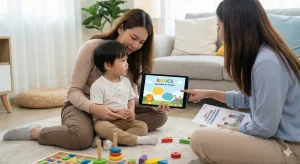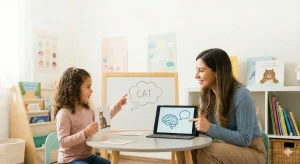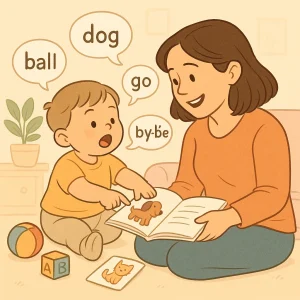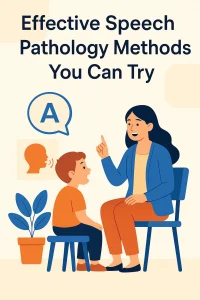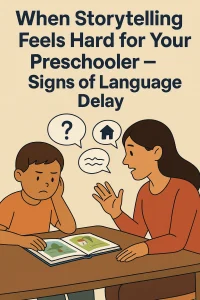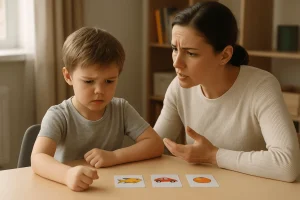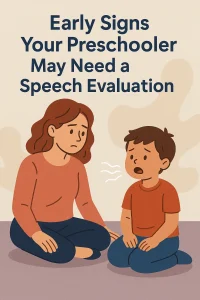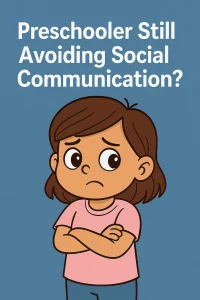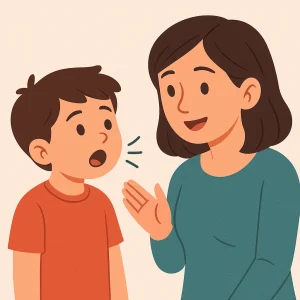6 Effective Speech Therapy Games for Young Children
Last Updated: June 14, 2024
Picture this: you’re playing with your child, and every sound they make feels like a small victory on their journey to speak clearly. Speech therapy can help, but what if it felt more like fun and less like work?
That’s where speech therapy games come in! These games make learning feel like play, helping your child enjoy their practice while building key communication skills. By using engaging effective speech therapy games for young children, you can turn ordinary moments at home into valuable learning opportunities. Kids love games, and when therapy feels playful, they’re more likely to stay engaged and make faster progress.
1. Touch and Feel Activities for Speech Therapy
Touch and feel activities are an excellent way to expand your child’s vocabulary and strengthen their descriptive language skills. Using everyday household items, you can create an engaging and educational experience that feels like play.
Description
To begin, gather a box or bag your child can’t see into, as well as a selection of household items with varying textures and shapes. For example, you could use a small stuffed animal, a ball, a piece of fruit, a toy car, Play-Doh, and a hairbrush. The key is to pick items that feel different from each other, which will prompt your child to think creatively and describe what they’re feeling.
Objective
The main goal of this activity is to help your child build their tactile vocabulary and practice describing objects in detail. As they feel and identify different items, they’ll learn new words and improve their ability to express themselves.
How to Play
1. Prepare the Game
Place the chosen items inside the box or bag without letting your child see them. Explain that this is a “mystery box” filled with hidden items to explore.
2. Start Guessing
Have your child reach into the box and feel an item. Encourage them to describe what they feel, using words like “soft,” “hard,” “cold,” “round,” or “fuzzy.” For example, if they pick up a stuffed animal, they might say it’s “soft and furry.”
3. Give Clues
If your child has trouble guessing, give gentle clues. For example, if they’re feeling a hairbrush, you might say, “We use this every morning to keep our hair neat.” This helps guide their thinking while introducing them to descriptive language.
4. Reveal and Learn
After each guess, reveal the item, say its name together, and talk about how it feels. This step reinforces the vocabulary and helps them remember the descriptive words they used.
Example Scenario
Let’s say your child pulls out an apple. They might say it’s “round and smooth.” If they’re unsure, you could prompt them with, “We eat this as a snack, and it’s crunchy and juicy inside.” Once they guess, you can talk about the apple’s other characteristics, like its color or smell, to deepen their understanding.
Benefits
Touch and feel activities are wonderful for expanding your child’s tactile vocabulary, which helps them associate words with sensations. This game also encourages them to use descriptive language, a key skill in effective communication. Plus, the process of guessing, feeling, and naming items makes learning more memorable and fun.
Also read: What is the Relation between Communication, Speech and Language? | Speech and Language Therapy
2. Freeze Dance for Kids’ Speech Development
Freeze Dance is a fun, high-energy game that can do wonders for your child’s speech development. By combining music, movement, and simple speech commands, this activity helps children build vocabulary and sharpen their listening skills—all while dancing and having a blast!
Description
Freeze Dance is a game where children move to music and follow spoken commands. This simple setup is a great way to introduce basic words and concepts like “stop,” “go,” and “freeze” in an engaging, memorable way. It’s ideal for helping young children learn new words and follow directions in a playful setting.
Objective
The primary aim of Freeze Dance is to teach children simple vocabulary words through action, like “stop,” “go,” and “freeze.” This game also supports their listening skills, word recognition, and ability to follow directions.
How to Play
1. Start the Music
Begin by playing lively music that your child enjoys, creating an inviting atmosphere for dancing. Encourage them to move freely to the rhythm, which will make the game feel like pure fun!
2. Use Simple Commands
For younger children, use basic commands like “stop” and “go.” Tell them that when you say “stop,” they should freeze in place, and when you say “go,” they can start dancing again. These simple cues help them connect the words to actions, reinforcing their understanding through repetition.
3. Introduce Rhyming Words
As your child becomes familiar with the game, you can add a challenge by using rhyming words. For example, they should freeze when they hear “freeze” but continue dancing if they hear similar-sounding words like “knees” or “cheese.” This encourages careful listening and helps them focus on word differences.
4. Mix It Up
To keep things exciting, vary the tempo of the music or add new commands like “jump” or “spin.” This variety keeps your child engaged and gives them more vocabulary to learn and respond to.
Example Scenario
Imagine you’re playing Freeze Dance with your child, and they’re happily dancing to the beat. You shout, “Freeze!” and they stop in place, grinning. To keep them on their toes, you add a rhyming word: “Knees!” They pause, listening intently, then realize it’s not “freeze” and start dancing again. This process of listening, processing, and acting reinforces their focus and builds vocabulary in a natural way.
Benefits
Freeze Dance is an excellent game for improving your child’s listening skills and word discrimination. By responding to specific words, children learn to listen carefully and act accordingly. The movement aspect also keeps them physically active, adding a bonus to this enjoyable learning game.
3. Scavenger Hunt: A Fun Speech Therapy Game
A Scavenger Hunt is an adaptable and fun game that can be played indoors or outdoors, making it perfect for any day or season. With a few simple clues and hidden items, this activity becomes an exciting adventure for kids that boosts vocabulary, listening skills, and critical thinking.
Description
In a Scavenger Hunt, children search for hidden items based on clues. The clues can be as easy or as challenging as needed to match the child’s age and language skill level. This versatile game not only supports language development but also encourages kids to think creatively and solve problems as they explore.
Objective
The main goal of a Scavenger Hunt is to build vocabulary and improve a child’s ability to follow directions. This engaging activity also promotes problem-solving and active learning, making it an excellent addition to any speech therapy routine.
How to Play
1. Prepare the Clues
Before starting, create a set of clues suited to the child’s age and comprehension level. For younger children, use simple and direct clues like “Find something you can eat.” For older kids, introduce a bit more challenge with clues that require critical thinking, like “I’m where you find frozen treats in the summer.”
2. Hide the Items
Choose several items to hide around the house or yard, such as toys or common household objects. Make sure each item is placed where the clue leads, and that the items are easy for your child to find.
3. Give the First Clue
Begin the game by sharing the first clue with your child. This clue should direct them to the location of the first hidden item. As they find each item, they’ll discover the next clue to continue the hunt.
4. Follow the Trail
Each item found should have the next clue attached, guiding the child along a trail until they reach the final item. This sequence keeps them actively engaged in the game.
Example Clues
- Simple Clue: “Find something you wear on your head.” (leads to a hat)
- Complex Clue: “I’m where you keep things cool and fresh; find me to get your next quest.” (leads to the refrigerator)
Example Scenario
Imagine you’re doing a Scavenger Hunt with your child on a rainy afternoon. You start with a clue like, “Look where you keep your shoes,” and your child runs off to check by the shoe rack, finding a small toy and the next clue. As they follow each hint, they practice listening closely, remembering directions, and thinking about each clue’s meaning. They’re learning new words and concepts without even realizing it, making this a wonderful way to sneak in a bit of language practice.
Benefits
A Scavenger Hunt is ideal for expanding vocabulary as children decipher clues, associate words with objects, and remember the names of each item they find. The activity also encourages active listening, as they must carefully follow each instruction to find the items. Plus, the game strengthens critical thinking, as kids solve clues along the way. And with all the excitement, they’ll stay physically active and engaged, making learning both fun and dynamic.
Also Read: Toddler Treasure Hunt: Learn & Play at Home
4. I Spy: Building Vocabulary Through Play
“I Spy” is a classic and engaging game that supports young children in developing speech skills through observation, description, and repetition. This simple yet powerful activity is perfect for practicing sound production and vocabulary in a playful, interactive setting.
Description
“I Spy” is a game where children identify and describe objects around them. This activity encourages them to observe their environment closely and articulate their thoughts. It’s an excellent way to build vocabulary and descriptive language skills through repetition.
Objective
The primary goal of “I Spy” is to practice sound production and phrase repetition, helping children expand their vocabulary and strengthen their language skills. This game also promotes careful listening and active participation, making it a great choice for speech development.
How to Play
1. Choose a Setting
“I Spy” can be played anywhere—whether you’re at home, in a park, or even on a drive. Select a location with plenty of objects in sight, giving your child various options to explore.
2. Start Spying
Begin the game by saying, “I spy with my little eye, something that is…” and describe an object based on its color, shape, size, or other characteristics. For example, you might say, “I spy something that is green and round” if you’re looking at a ball.
3. Encourage Participation
Ask your child to look around and guess the object you’re describing. Once they spot it, encourage them to repeat the phrase, “I spy…” and describe it back to you. This repetition reinforces their language skills and helps them feel more comfortable using descriptive language.
4. Focus on Sounds
If your child is practicing specific sounds, choose objects with those sounds in their names. For example, if they’re working on the /b/ sound, you could spy a “book” or a “bear.” This targeted approach allows them to practice specific speech sounds in a relaxed setting.
5. Expand Vocabulary
Let your child take turns spying and describing objects. Encourage them to use new words or longer phrases as they grow more confident. This step supports vocabulary building and helps them learn to express themselves in more detail.
Example Scenario
Imagine you’re at the park with your child, and you begin the game by saying, “I spy with my little eye, something that is yellow and buzzing.” Your child might look around and spot a bee, saying, “I spy a bee!” You can guide them through describing more about the bee, like its size or sound, to add to their vocabulary and make the game even more engaging.
Benefits
“I Spy” is fantastic for reinforcing vocabulary through repetition, helping children learn new words by using them in sentences. The game also enhances listening skills as children focus on your clues and search for specific objects. By focusing on particular sounds, “I Spy” can also support targeted speech practice in a fun, pressure-free way.
5. Animal Sounds: Practicing Speech with Fun Game
Animal Sounds is a playful and effective game that supports young children in developing their vocal skills and sound imitation. This fun activity is not only educational but also highly engaging, making it a perfect choice for speech therapy at home.
Description
In this game, children mimic the sounds of different animals, which helps them practice a variety of vocal pitches and sounds. By imitating these sounds, children enhance their speech and auditory discrimination skills, learning to recognize and produce different tones and rhythms in speech.
Objective
The main goal of Animal Sounds is to develop your child’s vocal skills and improve their ability to imitate sounds. This game also supports vocabulary building as children learn the names of various animals and the sounds they make.
How to Play
1. Choose Animals
Start by selecting a list of animals with distinct sounds, such as a cow (moo), cat (meow), dog (woof), sheep (baa), and duck (quack). This gives a nice variety of sounds for your child to practice.
2. Take Turns
Begin by making an animal sound and asking your child to guess the animal. For example, say “moo” and see if they can identify it as a cow. Then, switch roles—let your child make a sound while you guess the animal. This encourages active participation and keeps the game interactive.
3. Describe the Animals
Add a bit of learning by describing each animal before making its sound. For example, say, “This animal is very fluffy and lives on a farm. It says ‘baa.’ Can you guess what it is?” Descriptions like these help reinforce vocabulary and build connections between words and sounds.
4. Expand the Game
As your child becomes comfortable with basic animal sounds, add more animals or create a story involving different animals and their sounds. For example, you could say, “Once upon a time, a cow said ‘moo,’ and then a duck replied with a ‘quack.’” This storytelling approach makes the game even more engaging and allows for more complex language practice.
Example Scenario
Imagine playing Animal Sounds with your child. You begin with a classic, saying “woof, woof!” and watching as they gleefully call out “dog!” Next, your child makes a “quack” sound, and you respond, “That’s right, a duck!” You then add a fun description: “The duck waddled over to the pond and splashed with its friends.” This approach keeps the game lively and provides a gentle, engaging way to practice sound imitation and vocabulary.
Benefits
Animal Sounds is a wonderful game for helping children develop speech skills through sound imitation, which strengthens their ability to recognize and produce varied sounds. This game also builds vocabulary as they learn animal names and their corresponding sounds. Listening closely and trying to replicate each sound encourages auditory discrimination, a crucial skill in language development.
Also Read: Learn Animal Sounds: Fun Speech Therapy at Home
6. Building Blocks for Speech Therapy
Building Blocks is a fantastic game for helping young children develop language skills through hands-on play. Using blocks or Legos to create structures adds an interactive, visual element to speech practice, making it both fun and educational.
Description
In this activity, children use blocks or Legos to build various structures while narrating their actions and making specific requests. This game is an excellent way to introduce new vocabulary and sentence structure, as children describe colors, shapes, and actions while they play.
Objective
The main goal of Building Blocks is to teach vocabulary and sentence structure in a natural, engaging way. This activity encourages children to use descriptive language and express themselves with more detailed sentences.
How to Play
1. Gather Materials
Collect an assortment of blocks or Legos in different colors, shapes, and sizes. Having a variety of options will give your child more opportunities to describe and request specific pieces.
2. Start Building
Begin by building a simple structure and narrating each step. For example, say, “I am placing a red block on top of the blue block.” By verbalizing your actions, you model sentence structure and descriptive language for your child to imitate.
3. Encourage Requests
As you play, encourage your child to ask for specific blocks. For example, if they need a certain piece, prompt them to ask for it by color or size, like “Can I have the big red block?” or “I need a small green block.” This encourages them to practice using descriptive words.
4. Expand Sentences
Help your child build more complex sentences by expanding on their phrases. For example, if they say, “I build tower,” you can respond with, “Yes, you are building a tall tower with green and yellow blocks!” This gently guides them toward using more detailed language.
5. Interactive Play
Engage your child with questions about their building process. Ask them to describe what they’re building or explain why they chose certain blocks. For example, you might say, “What are you building?” or “Why did you choose that big block for the bottom?” This back-and-forth interaction encourages them to think about and verbalize their actions.
Example Scenario
Imagine playing Building Blocks with your child. As you build, you say, “I’m using a red block to make the base.” Your child requests, “Can I have a blue block?” After handing it over, you encourage them to expand by asking, “Where will you put the blue block?” They respond, “On top of the green one!” This kind of interaction keeps them engaged while helping them practice descriptive and structured sentences.
Benefits
Building Blocks is an ideal game for teaching vocabulary and sentence structure. It encourages children to use descriptive language, such as colors and sizes, and practice forming complete sentences. Additionally, it strengthens fine motor skills and spatial awareness as they manipulate the blocks.
Building Blocks Activity for Language Development in Speech Therapy
| Aspect | Description |
| Game Name | Building Blocks |
| Objective | To teach vocabulary and sentence structure through interactive play. |
| Materials Needed | A variety of blocks or Legos in different colors, shapes, and sizes. |
| How to Play | – |
| Step 1: Gather Materials | Collect blocks or Legos with a range of colors, shapes, and sizes to provide options for descriptive play. |
| Step 2: Start Building | Begin creating a simple structure and narrate each action (e.g., “I am placing a red block on top of the blue block”) to model language for the child. |
| Step 3: Encourage Requests | Prompt your child to request specific blocks by color, size, or shape (e.g., “Can I have the yellow block?” or “I need a small blue block”). |
| Step 4: Expand Sentences | Help your child build sentences by expanding their phrases (e.g., if they say, “I build tower,” respond with, “You are building a tall tower with red blocks!”). |
| Step 5: Interactive Play | Ask your child questions about their building process, encouraging them to describe what they’re doing or why they chose certain blocks. |
| Example Scenario | You build with your child, narrating actions and expanding their sentences. For instance, your child says, “Can I have a blue block?” You respond, “Sure! Where will you place it?” |
| Benefits | Teaches vocabulary, encourages descriptive language, practices sentence structure, develops fine motor skills, and promotes spatial awareness. |
Know more about on How Long Will My Child Need Speech Therapy?
Conclusion
Using games for speech therapy is a great way to help young children improve their communication skills. The activities we’ve talked about—Touch and Feel, Freeze Dance, Scavenger Hunt, I Spy, Animal Sounds, and Building Blocks—make learning fun and help children learn new words, listen better, and talk more clearly. These games turn practice into playtime, which keeps children interested and happy to learn.
As a parent, you can easily include these games in your daily routine to help your child with their speech. These games are not only fun but also very effective in helping children talk better. For more tips and ideas, visit Wellness Hub, where you can find lots of useful information to support your child’s speech development. We hope you try these games at home and see how much they can help your child.
Frequently Asked Questions:
1. What are some effective speech therapy games for young children?
Effective speech therapy games for young children can include Touch and Feel, Freeze Dance, and more. These games are fun and help improve vocabulary, listening skills, and speech development.
2. How can I use Touch and Feel activities to enhance my child’s speech development?
Touch and Feel activities involve using a box or bag filled with various household items. Children reach in, feel the item, and describe it. This helps improve their tactile vocabulary and descriptive language skills.
3. What is the objective of playing Freeze Dance in speech therapy?
The objective of Freeze Dance is to teach basic vocabulary and listening skills. Children dance to music and follow commands like “stop” and “go,” helping them learn new words and improve their ability to listen and respond.
4. How does the I Spy game benefit speech development in children?
The I Spy game helps children practice sound production and phrase repetition. By identifying and describing objects around them, children learn new words and improve their observational and descriptive skills.
5. Can Animal Sounds games help with speech therapy?
Yes, Animal Sounds games are excellent for developing vocal skills and sound imitation. Children take turns making and guessing animal sounds, which helps them practice different vocal pitches and expand their vocabulary.
6. How do Building Blocks support language development in children?
Building Blocks activities involve using blocks or Legos to build structures while narrating actions and encouraging specific requests. This helps children learn new vocabulary, practice sentence structure, and improve their communication skills.
7. Why are speech therapy games important for young children?
Speech therapy games make learning fun and engaging for young children. They help improve vocabulary, listening skills, and speech clarity through play, making the practice more enjoyable and effective.
8. How often should I play these speech therapy games with my child?
Consistency is key. Try to incorporate these games into your daily routine, even if it’s just for a few minutes each day. Regular practice can significantly enhance your child’s speech development.
9. Where can I find more resources and tips for speech therapy at home?
For more tips and resources on speech therapy, visit Wellness Hub. Wellness Hub offers a variety of tools and information to support your child’s speech development journey.
10. Are these speech therapy games suitable for all ages?
While these games are particularly effective for young children, they can be adapted for different age groups. Adjust the complexity of the tasks to match your child’s developmental level.
About the Author:
Anuradha Karanam
Speech-language pathologist (7+ years of experience)
Anuradha Karanam is a skilled speech-language pathologist with over 6 years of experience. Fluent in Tamil, Telugu, Hindi, and English, she specializes in parent counseling, speech sound disorders, fluency assessment, and speech-language evaluations. Anuradha excels at working with children with developmental disorders, offering creative and effective therapy programs. Currently, at Wellness Hub, she holds a BASLP degree and is registered with the RCI (CRR No A85500). Her patience, ambition, and dedication make her a trusted expert.
Connect with Anuradha to learn more about how she can help you or your loved one find their voice.
Book your Free Consultation Today
Parent/Caregiver Info:
Client’s Details:
* Error Message
